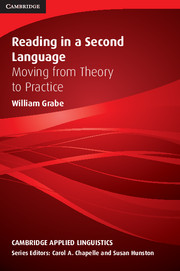Series editors' preface
Published online by Cambridge University Press: 05 August 2012
Summary
As much has been written about reading and reading instruction as perhaps any issue in education, and attempting to synthesize this large body of theory and research, as well as explore its implications for the pedagogy of reading instruction, is a Herculean task. Bill Grabe, however, is one scholar whose knowledge of the field of first and second language reading theory and instruction is second to none, and in this book he draws on a long and active career as a researcher and applied linguist to survey what is known about the nature of both first and second language reading and examine the implications of this research for reading instruction. In the process he provides a fascinating and broad ranging view of the state of knowledge in reading theory, and draws on this body of knowledge to draw implications for the teaching of second language reading.
Grabe points out that the starting point for our understanding of L2 reading is an understanding of what has been learned from L1 reading research, and that much of the literature of L2 reading instruction is based on applying what has been learned from L1 research. Grabe leads the reader through a wide range of reading theories and reading research, highlighting findings from L1 research that are of most relevance to L2 reading instruction. Atthe same time issues specific to L2 reading are also given due prominence, including differences between L1 andL2 reading, the role of transfer in L2 reading, and the interaction of L1 and L2 reading resources in L2 reading.
- Type
- Chapter
- Information
- Reading in a Second LanguageMoving from Theory to Practice, pp. xi - xiiPublisher: Cambridge University PressPrint publication year: 2008

